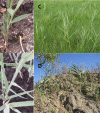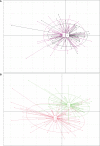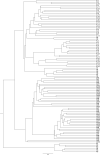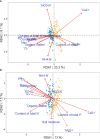Contrasting patterns of genetic and phenotypic divergence of two sympatric congeners, Phragmites australis and P. hirsuta, in heterogeneous habitats
- PMID: 38162310
- PMCID: PMC10756910
- DOI: 10.3389/fpls.2023.1299128
Contrasting patterns of genetic and phenotypic divergence of two sympatric congeners, Phragmites australis and P. hirsuta, in heterogeneous habitats
Abstract
Habitat heterogeneity leads to genome-wide differentiation and morphological and ecological differentiation, which will progress along the speciation continuum, eventually leading to speciation. Phragmites hirsuta and Phragmites australis are sympatric congeners that coexist in saline-alkaline meadow soil (SAS) and sandy soil (SS) habitats of the Songnen Meadow. The results provided genetic evidence for two separate species of reeds. Genetic diversity and spatial genetic structure supported the specialist-generalist variation hypothesis (SGVH) in these two sympatric reed species, suggesting that P. australis is a generalist and P. hirsuta is a habitat specialist. When we compared these different species with respect to phenotypic and genetic variation patterns in different habitats, we found that the phenotypic differentiation of P. australis between the two habitats was higher than that of P. hirsuta. Multiple subtle differences in morphology, genetic background, and habitat use collectively contribute to ecological success for similar congeners. This study provided evidence of the two reed congeners, which should contribute to their success in harsh environments.
Keywords: Phragmites australis; Phragmites hirsuta; coexistence; generalist; habitat; heterogeneity; specialist.
Copyright © 2023 Qiu, Liu, Li, Yang, Liu and Yang.
Conflict of interest statement
The authors declare that the research was conducted in the absence of any commercial or financial relationships that could be construed as a potential conflict of interest.
Figures








Similar articles
-
Genetic and epigenetic diversity and structure of Phragmites australis from local habitats of the Songnen Prairie using amplified fragment length polymorphism markers.Genet Mol Res. 2016 Aug 19;15(3). doi: 10.4238/gmr.15038585. Genet Mol Res. 2016. PMID: 27706594
-
Epigenetic variation associated with responses to different habitats in the context of genetic divergence in Phragmites australis.Ecol Evol. 2021 Jul 30;11(17):11874-11889. doi: 10.1002/ece3.7954. eCollection 2021 Sep. Ecol Evol. 2021. PMID: 34522347 Free PMC article.
-
[Biomass allocation and growth analysis on the ramets of Phragmites communis populations in different habitats in the Songnen Plains of China].Ying Yong Sheng Tai Xue Bao. 2003 Jan;14(1):30-4. Ying Yong Sheng Tai Xue Bao. 2003. PMID: 12722434 Chinese.
-
Cosmopolitan Species As Models for Ecophysiological Responses to Global Change: The Common Reed Phragmites australis.Front Plant Sci. 2017 Nov 16;8:1833. doi: 10.3389/fpls.2017.01833. eCollection 2017. Front Plant Sci. 2017. PMID: 29250081 Free PMC article. Review.
-
Phytoremediation potential and control of Phragmites australis as a green phytomass: an overview.Environ Sci Pollut Res Int. 2019 Mar;26(8):7428-7441. doi: 10.1007/s11356-019-04300-4. Epub 2019 Jan 28. Environ Sci Pollut Res Int. 2019. PMID: 30693445 Review.
Cited by
-
The Potential Role of Genic-SSRs in Driving Ecological Adaptation Diversity in Caragana Plants.Int J Mol Sci. 2024 Feb 8;25(4):2084. doi: 10.3390/ijms25042084. Int J Mol Sci. 2024. PMID: 38396759 Free PMC article.
-
Ecological Isolation Maintains the Species Boundaries Between Two Sympatric Cycas From Southwest China.Ecol Evol. 2025 Jul 8;15(7):e71769. doi: 10.1002/ece3.71769. eCollection 2025 Jul. Ecol Evol. 2025. PMID: 40635798 Free PMC article.
References
-
- Chinese Academy of Sciences (2004). Flora of China (Beijing: Editorial Committee, Flora of China, Science Press; ), 25–30.
-
- Denelle P., Violle C., Consortium D., Munoz F. (2020). Generalist plants are more competitive and more functionally similar to each other than specialist plants: insights from network analyses. J. Biogeography 47, 1922–1933. doi: 10.1111/jbi.13848 - DOI
Associated data
LinkOut - more resources
Full Text Sources

